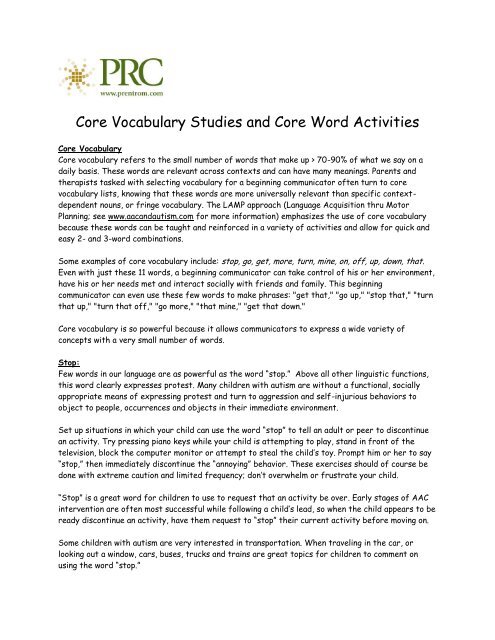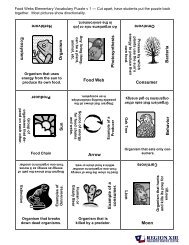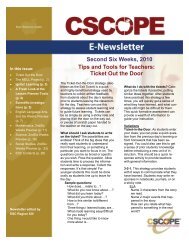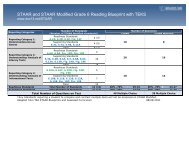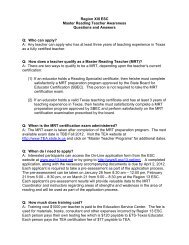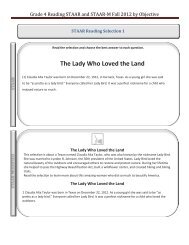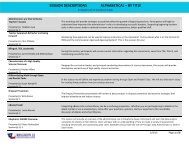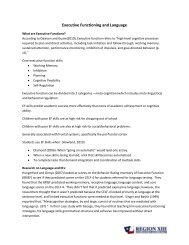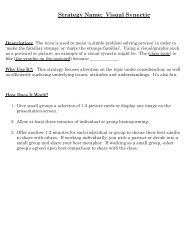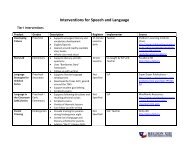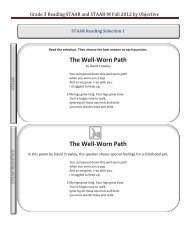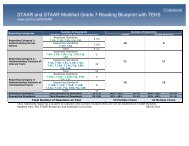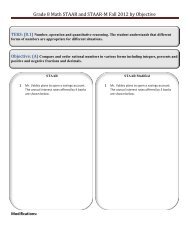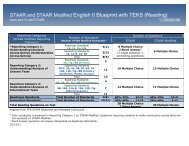Core Vocabulary Studies and Core Word Activities handout
Core Vocabulary Studies and Core Word Activities handout
Core Vocabulary Studies and Core Word Activities handout
You also want an ePaper? Increase the reach of your titles
YUMPU automatically turns print PDFs into web optimized ePapers that Google loves.
<strong>Core</strong> <strong>Vocabulary</strong> <strong>Studies</strong> <strong>and</strong> <strong>Core</strong> <strong>Word</strong> <strong>Activities</strong><br />
<strong>Core</strong> <strong>Vocabulary</strong><br />
<strong>Core</strong> vocabulary refers to the small number of words that make up > 70-90% of what we say on a<br />
daily basis. These words are relevant across contexts <strong>and</strong> can have many meanings. Parents <strong>and</strong><br />
therapists tasked with selecting vocabulary for a beginning communicator often turn to core<br />
vocabulary lists, knowing that these words are more universally relevant than specific contextdependent<br />
nouns, or fringe vocabulary. The LAMP approach (Language Acquisition thru Motor<br />
Planning; see www.aac<strong>and</strong>autism.com for more information) emphasizes the use of core vocabulary<br />
because these words can be taught <strong>and</strong> reinforced in a variety of activities <strong>and</strong> allow for quick <strong>and</strong><br />
easy 2- <strong>and</strong> 3-word combinations.<br />
Some examples of core vocabulary include: stop, go, get, more, turn, mine, on, off, up, down, that.<br />
Even with just these 11 words, a beginning communicator can take control of his or her environment,<br />
have his or her needs met <strong>and</strong> interact socially with friends <strong>and</strong> family. This beginning<br />
communicator can even use these few words to make phrases: "get that," "go up," "stop that," "turn<br />
that up," "turn that off," "go more," "that mine," "get that down."<br />
<strong>Core</strong> vocabulary is so powerful because it allows communicators to express a wide variety of<br />
concepts with a very small number of words.<br />
Stop:<br />
Few words in our language are as powerful as the word “stop.” Above all other linguistic functions,<br />
this word clearly expresses protest. Many children with autism are without a functional, socially<br />
appropriate means of expressing protest <strong>and</strong> turn to aggression <strong>and</strong> self-injurious behaviors to<br />
object to people, occurrences <strong>and</strong> objects in their immediate environment.<br />
Set up situations in which your child can use the word “stop” to tell an adult or peer to discontinue<br />
an activity. Try pressing piano keys while your child is attempting to play, st<strong>and</strong> in front of the<br />
television, block the computer monitor or attempt to steal the child‟s toy. Prompt him or her to say<br />
“stop,” then immediately discontinue the “annoying” behavior. These exercises should of course be<br />
done with extreme caution <strong>and</strong> limited frequency; don‟t overwhelm or frustrate your child.<br />
“Stop” is a great word for children to use to request that an activity be over. Early stages of AAC<br />
intervention are often most successful while following a child‟s lead, so when the child appears to be<br />
ready discontinue an activity, have them request to “stop” their current activity before moving on.<br />
Some children with autism are very interested in transportation. When traveling in the car, or<br />
looking out a window, cars, buses, trucks <strong>and</strong> trains are great topics for children to comment on<br />
using the word “stop.”
Many children love to be able to control their environment <strong>and</strong> the behavior of others. Engage your<br />
child with silly dancing, running, jumping <strong>and</strong> movement <strong>and</strong> then prompt them to tell you to “stop.”<br />
Exaggeratedly “stop” moving by freezing your whole body or even by falling down. Using “stop” to<br />
direct the behavior of others may be a great way to involve a family pet or therapy dog.<br />
Remember, we are all multi-modal communicators! Pair your verbalization <strong>and</strong> device activation of<br />
“stop” with a gesture – arm stretched out with palm facing outwards <strong>and</strong> encourage your child to do<br />
the same.<br />
Other core words that pair well in activities:<br />
STOP & GO : As discussed in the last post, “stop” pairs easily with “go” for many movement-related<br />
activities. Try using “stop” while swinging, bouncing, jumping <strong>and</strong> other sensory/motor activities. In<br />
classroom <strong>and</strong> group therapy activities, allow the child to direct music <strong>and</strong> movement activities using<br />
“stop” <strong>and</strong> “go.” Other things that can both “stop” <strong>and</strong> “go” are music, videos, fans <strong>and</strong> moving toys.<br />
STOP THAT/STOP IT: “That” <strong>and</strong> “it” are great words for communicators at the 2-word level to<br />
pair when protesting.<br />
Go:<br />
The word “go” has so many meanings <strong>and</strong> uses in English that it can be applied in almost any activity.<br />
The most obvious applications are those involving movement (bouncing on a ball, swinging, jumping on<br />
a trampoline, running). The word “go” also comes with a built-in socially relevant verbal prompt:<br />
“ready… set…”.<br />
For children who are motivated by moving toys, bubbles, videos <strong>and</strong> music, “go” is a great word for<br />
them to ask for initiation.<br />
Many children enjoy being able to control the behavior of other people. The word “go” can empower<br />
a child to direct his peers to “go” during dancing/movement games, tell an adult to do a somersault,<br />
tap dance or make silly faces. The child using the device can direct music to “go” during a game of<br />
musical chairs or to initiate a relay race.<br />
Remember that core words are relevant for many communicative functions! Let a child protest your<br />
involvement in an activity by telling you to “go” away or allow him or her to comment on someone<br />
else‟s activity (if someone walks out of the room, he/she may say “go”).<br />
Other core words that pair well in activities:<br />
COME & GO – Sneak up or run up to the child when he/she says “come,” then leave when he/she<br />
says “go.”<br />
STOP & GO – Most activities that can “go” can also “stop.” Play <strong>and</strong> pause music <strong>and</strong> videos, make a<br />
fan “stop” <strong>and</strong> “go.”<br />
GO UP/DOWN – Physical activities like climbing <strong>and</strong> sliding are great opportunities to teach the<br />
prepositions. Many preschool toys have slides, ramps <strong>and</strong> chutes for action figures, cars <strong>and</strong> balls to<br />
“go up” <strong>and</strong> “go down.”<br />
Be creative! Remember to follow the child‟s lead <strong>and</strong> help him/her find appropriate vocabulary to<br />
request, comment, protest <strong>and</strong> direct.
Turn:<br />
Look up “turn” in the dictionary <strong>and</strong> you may find over 100 different uses!<br />
“Turn” is a great word to talk about any activity or object that rotates or spins. Engage your child<br />
in play with spinning toys by making them “turn” <strong>and</strong> stop.<br />
Engage in fun dancing activities in the classroom <strong>and</strong> let the child direct students or teachers to<br />
“turn” while dancing. Many children like to be spun on the swing; allow them to direct you by saying<br />
“turn me” “turn it” or “turn swing.”<br />
“Turn” is a very relevant word to use with any activity or object with an on/off switch or volume<br />
control. Model using phrases like “turn it on,” or “turn that up” when playing with toys, listening to<br />
music or watching videos. Allow your child to object to songs or shows that he or she doesn‟t like by<br />
saying “turn that off” asking to “turn down” the volume.<br />
Have some fun gently sabotaging your child‟s routine by “turning” their clothes inside out, holding a<br />
book backwards or offering them a cup upside down. Help them problem-solve these silly situations<br />
<strong>and</strong> tell you to “turn” them. Other problem-solving activities can involve a child directing you to<br />
“turn” a key to access a locked room or “turn” a screwdriver to replace dead batteries.<br />
Because one meaning of the word “turn” is to change directions, it is a great word for kids to use to<br />
control movement activities. Pull your child on a wagon or push them on a scooter, then change<br />
directions when they direct you to “turn.” Model the use of the word when riding in the car or<br />
watching traffic from the window to describe the movement of cars, trucks <strong>and</strong> buses.<br />
Allow your child to control the pace while reading books or looking at photo albums by telling you to<br />
turn the page.<br />
One of the most popular applications of the word “turn” in school <strong>and</strong> intervention programs is for<br />
turn-taking during game play. This is a great opportunity for your child to learn pronouns like “my,”<br />
“your,” “his” <strong>and</strong> “her,” so be sure that your child‟s device allows him or her the opportunity to<br />
combine pronouns with “turn,” instead of having one button say “my turn” or “your turn.”<br />
Get:<br />
The word “get” pairs nicely with nouns, pronouns <strong>and</strong> prepositions for so many different<br />
communicative functions. Children can say phrases like: “get up,” “get in,” “get that,” “get me,” “get<br />
wet,” “get on” “get mom,” <strong>and</strong> “get silly” in many fun activities.<br />
A child who loves to be chased <strong>and</strong> tickled may very quickly learn to use the 2-word combination<br />
“get me” to initiate rough <strong>and</strong> tumble play. After catching <strong>and</strong> tickling your child, continue teaching<br />
pronouns by saying “I got you” while modeling on his/her device. During recess or group play dates,<br />
encourage your child to initiate chasing games to “get” his/her peers.<br />
“Get” can be a powerful word for a child to use to request items that are out of sight or out of<br />
reach. Teach your child to use “get it” or “get that” <strong>and</strong> he or she can direct you retrieve preferred
toys or food items. During classroom routines, model the use of “get” when directing children to<br />
prepare for activities (e.g., “get” your books, “get” your coats). We can use “get” to access people<br />
as well; a child can ask an adult to “get mom” or “get” a peer or sibling.<br />
Pair “get” with prepositions during movement play. Try creating an obstacle course in which your<br />
child must “get down” to crawl under a barrier, “get in” <strong>and</strong> “get out” of a tunnel or ball pit, “get<br />
over” a barrel, “get on” <strong>and</strong> “get off” therapy ball <strong>and</strong> then “get up” a set of stairs. Let your child<br />
direct you or his/her peers when it is their turn to do this activity. “Get up” is a great phrase to use<br />
after sitting on the floor, falling down or pretending to sleep.<br />
The word “get” can be used to mean “become.” Have fun talking about <strong>and</strong> learning emotions <strong>and</strong><br />
basic concepts by modeling <strong>and</strong> prompting phrases like “get happy,” “get tired,” “get silly” or “get<br />
wet.”<br />
Up & Down:<br />
The prepositions “up” <strong>and</strong> “down” have meanings beyond simple directions. We can “get up,” “clean<br />
up,” “stay up,” “blow up,” “fall down,” “lie down,” “sit down” <strong>and</strong> “slow down.”<br />
Gently sabotage music, TV <strong>and</strong> computer activities by adjusting the sound volume. Have your child<br />
direct you to turn it “up” or “down.” Lights can also be turned “up” <strong>and</strong> “down.” A child who can ask<br />
for undesired sounds to be turned “down” or for lights to be turned “up” is empowered to modify<br />
his/her environment to a more comfortable sensory level.<br />
Let a child ask you to retrieve specific toys from a shelf by asking for them to be put “down,” then<br />
when the child is done playing, you can put the toys “up.”<br />
“Up” <strong>and</strong> “down” are great words to use when doing gross motor activities. Talk about going “up” <strong>and</strong><br />
“down” stairs, jumping “up” <strong>and</strong> “down” or even rolling a barrel or a ball “up” <strong>and</strong> “down” a large<br />
wedge or hill. A child can asked to be picked “up” or put “down.”<br />
Many songs <strong>and</strong> word plays use the words “up” <strong>and</strong> “down.” Let your child fill-in-the-blanks for Ring-<br />
Around-the-Rosy, Itsy Bitsy Spider, <strong>and</strong> the Wheels on the Bus.<br />
Help your child use prepositions to ask to be picked “up” <strong>and</strong> put “down” <strong>and</strong> describe falling “down”<br />
<strong>and</strong> getting “up.”<br />
Many of your child‟s favorite activities may easily use the words “up” <strong>and</strong> “down.” Car race toys,<br />
videos of rollercoasters, dollhouses with stairs, building blocks/Legos, or blowing bubbles.<br />
Open & Close:<br />
Opposites “open” <strong>and</strong> “close” are great words to target in a variety of activities. We can “open” <strong>and</strong><br />
“close” so many things in our environment: eyes, toys, boxes, drawers, containers, laptops, windows,<br />
refrigerators, etc!<br />
A ride in the car is a great opportunity to use the words “open” <strong>and</strong> “close.” You <strong>and</strong> your child can<br />
talk about “opening” <strong>and</strong> “closing” the car doors, windows, glove compartments <strong>and</strong> even the AC<br />
vents.
Try working on “open” during mealtimes as an alternative way to request a favorite food; h<strong>and</strong> your<br />
child his/her favorite food in a difficult-to-open container <strong>and</strong> prompt them to direct you to open<br />
it. Have your child participate in food preparation or clean-up by having them “open” <strong>and</strong> “close” the<br />
refrigerator, cupboards, pantry or dishwasher. Model the word “open” when using a can opener <strong>and</strong><br />
“close” when sealing food items.<br />
Use computer-based activities to teach these words by “opening” <strong>and</strong> “closing” a laptop, CD-ROM<br />
drive, game jewel cases <strong>and</strong> browser windows. Favorite games or computer accessories that are<br />
kept in a drawer or file can be accessed using the word “open.”<br />
Gently sabotage your child‟s routines by placing favorite toys inside of locked drawers or difficultto-open<br />
containers (e.g., large pretzel jars or canning jars with a metal clamp) <strong>and</strong> prompt them to<br />
direct you to “open” it. Leave a normally “closed” door “open” <strong>and</strong> have your child direct you to<br />
“close” it.<br />
Have fun making silly faces by letting your child direct you to “open” <strong>and</strong> “close” your eyes, nose <strong>and</strong><br />
mouth.<br />
Even more things that open <strong>and</strong> close: books, mailboxes, envelopes, new toys, presents, drawers,<br />
h<strong>and</strong>s, water bottles, folders, purses, nail polish, window shades/blinds, gates <strong>and</strong> computer<br />
programs.<br />
On:<br />
The word “on” is relevant in so many contexts: traveling (“on” a bus), mealtimes (putting food “on” a<br />
plate), playing (“on” the computer) <strong>and</strong> dressing (putting “on” clothes). Get “on” the discussion page<br />
for more ideas on this great core word!<br />
We use the word “on” frequently to discuss locations. Allow your child to direct you or peers to sit<br />
“on” a chair, put something “on” a table or shelf or st<strong>and</strong> “on” a stool. Your child could take a turn<br />
giving directions during a game of Twister (e.g., “foot on red”).<br />
Allow your child to direct you or make choices about art activities: color “on” the paper, put glitter<br />
“on” the page, <strong>and</strong> paint “on” the canvas.<br />
The word “on” can be used to describe traveling – we can ride “on” a bus, “on” a train, “on” an<br />
airplane, “on” a bike, “on” a horse or even “on” someone‟s shoulders.<br />
Let your child help set the table at mealtimes by putting plates <strong>and</strong> utensils “on” the table, food “on<br />
the plates <strong>and</strong> salt “on” the food.<br />
Have fun being silly while learning about body parts by putting play-doh or stickers “on” your child‟s<br />
nose, knee or elbow. Continue with silly dress-up games <strong>and</strong> put “on” shoes, dresses, wigs, hats <strong>and</strong><br />
even make-up or face paint.<br />
Many things in your child‟s environment have on/off switches: computers, lights, toys, flashlights,<br />
kitchen appliances, TVs, radios, cars, fans, water faucets. Use these motivating <strong>and</strong> routine
activities to teach the word “on.” As your child‟s language grows, add some more core words to say<br />
“turn it on.”<br />
In:<br />
“In” is another frequently-used preposition that can be used in so many contexts. We can go “in” a<br />
room, put our foot “in” our shoe, pour juice “in” a cup, crawl “in” a tunnel, put a CD “in” a CD player,<br />
<strong>and</strong> get “in” bed.<br />
During transitions around school or in the community, talk about getting “in” the car, going “in” the<br />
doctor‟s office, walking “in” the store, going “in” the classroom, sitting “in” the chair <strong>and</strong> going “in”<br />
the therapy room.<br />
While getting dressed, you can play a silly game while learning about body parts; put your child‟s<br />
h<strong>and</strong> “in” his /her shoe instead of his/her foot, then have him/her correct you <strong>and</strong> tell you to put<br />
his/her foot “in.” Do the same thing with your child‟s arm “in” pants, leg “in” a shirt <strong>and</strong> even head<br />
“in” underwear!<br />
During clean-up time, “in” is a very frequently used word. Have your child direct you or peers to put<br />
toys, clothes, dishes, etc. “in” a box, “in” the drawer, “in” the bag, “in” their backpack or “in” the<br />
closet.<br />
Let your child participate at mealtimes by helping you pour juice “in” the cup or pour cereal “in” the<br />
bowl. While preparing for school, your child can help pack his/her lunch or snack by putting food<br />
items “in” his/her lunchbox.<br />
In your OT gross motor/sensory gym, your child can ask to get “in” a tunnel, “in” a barrel or even<br />
“in” a taco-shaped swing. Many OT spaces <strong>and</strong> preschools have sensory bins full of s<strong>and</strong>, rice or<br />
beans that you can hide toys "in." Direct your child to put toys or letters "in" the bins, then put<br />
his/her h<strong>and</strong>s "in" to find them again.<br />
Many of your child‟s favorite leisure <strong>and</strong> therapeutic activities can incorporate the word “in.” Have<br />
your child request his/her favorite CD or DVD to be put “in” the player, put pieces “in” a puzzle <strong>and</strong><br />
shapes “in” the shape sorter. Many preschool toys are manipulated by putting a ball, car or figure<br />
“in” the toy.<br />
Use “in” during evening routines; talk to your child about getting “in” the bath, putting his/her<br />
toothbrush “in” his/her mouth, spitting “in” the sink <strong>and</strong> finally getting “in” bed.<br />
Off:<br />
The preposition “off” can be applied in so many settings <strong>and</strong> activities. Your child can modify<br />
his/her environment by asking for bright lights or loud noises to be turned “off,” ask for help<br />
getting his/her coat “off,” tell you to jump “off” a step or describe taking “off” a lid.<br />
During cleaning routines, you <strong>and</strong> your child can take items “off” the table, sweep “off” the floor<br />
<strong>and</strong> clean “off” or wipe “off” the tables.
When arriving at school, model using the word “off” while directing your child to take “off” his/her<br />
coat <strong>and</strong> backpack. At the end of the day, talk about getting undressed by describing taking “off”<br />
socks, shoes, pants <strong>and</strong> shirts. After dress-up games or cold winter days, there are even more<br />
things to take “off:” coats, gloves, headb<strong>and</strong>s, hats, wigs <strong>and</strong> even nail polish!<br />
Your child can ask for help access preferred foods, drinks or toys by asking for a lid to be taken<br />
“off” or by asking for items to be taken “off” a high shelf.<br />
Many items <strong>and</strong> activities in your child‟s daily life can be turned “off.” Have your child direct you or<br />
peers to turn “off” the water, turn “off” the lights, turn “off” the car, turn “off” the music <strong>and</strong><br />
turn “off” the TV. The word “off” can be empowering for a child who is easily overwhelmed by<br />
sensory stimuli ; if your child can ask for bright lights to be turned “off” or for loud music to be<br />
turned “off,” he/she can take control of regulating his/her environment.<br />
“Off” is a relevant word in many leisure <strong>and</strong> therapy activities. We can get “off” a bike, swing or<br />
horse. Because movement can be motivating to many children, we can talk about jumping “off” a step<br />
or falling “off” the bed. Wind-up toys can also fall or jump “off” surfaces.<br />
Make:<br />
The word “make” is one of the most versatile core words in our vocabulary. We can “make” money,<br />
“make” noise, “make” friends, “make” a phone call, “make” faces, “make” a phone call <strong>and</strong> “make”<br />
people laugh. “Make” can mean to create, to cause <strong>and</strong> to control <strong>and</strong> it is used in many common<br />
idioms. “<br />
The word “make” is commonly used in the kitchen. Involve your child when it is time to “make” meals.<br />
Your child may enjoy getting to “make” kool-aid, “make” cookies, “make” pizza or “make” macaroni<br />
<strong>and</strong> cheese.<br />
Many children enjoy playing with play-doh <strong>and</strong> “making” different shapes <strong>and</strong> objects. Describe the<br />
shapes you “make” with cookie cutters <strong>and</strong> let your child direct you to “make” familiar objects.<br />
Exp<strong>and</strong> on these utterances with color vocabulary (e.g., “make a yellow ball” or “make a blue star”).<br />
Because the word “make” can mean “create,” craft activities are great opportunities to teach <strong>and</strong><br />
use this word. We can “make” pictures, “make” dots, “make” stripes, “make” circles <strong>and</strong> “make”<br />
sculptures.<br />
In music class or therapy, encourage your child to “make” noise with instruments or to “make” it<br />
loud <strong>and</strong> “make” it quiet.<br />
“Make” can be used to mean “cause” or “control.” Let your child control your behavior <strong>and</strong> “make”<br />
you jump, “make” you laugh or “make” you sleep. Your child can direct you to control objects or<br />
activities in his/her environment; when playing with a moving toy, he/she can ask you to “make” it<br />
stop or “make” it go.<br />
Fast & Slow:
The words “fast” <strong>and</strong> “slow” can describe the speed of movement, music, visual stimuli <strong>and</strong> sensory<br />
stimuli. We can “go fast,” “slow down,” “swing fast,” “sing slow,” “jump fast” <strong>and</strong> “walk slow.” Allow<br />
your child to control the speed of preferred <strong>and</strong> daily activities using these common adjectives.<br />
“Fast” <strong>and</strong> “slow” very commonly describe movement <strong>and</strong> since many children with autism are<br />
motivated by movement, these words are very relevant. Allow your child to set the pace of sensory<br />
activities in the OT gym while swinging, jumping, rolling in a barrel, running, crossing balance beams,<br />
riding bikes <strong>and</strong> climbing. Teach the meanings of “fast” <strong>and</strong> “slow” by having your child complete an<br />
obstacle course at different speeds.<br />
Music class or music therapy is another great environment for your child to learn about “fast” <strong>and</strong><br />
“slow.” Alternate playing instruments or singing “fast” <strong>and</strong> “slow” <strong>and</strong> allow your child to make<br />
choices about how they would like you to sing routine songs. Your child may also control the speed at<br />
which he/she <strong>and</strong> his/her peers dance <strong>and</strong> move during music time.<br />
Some video <strong>and</strong> audio equipment allows for varying speeds. Your child may enjoy watching familiar<br />
videos or even videos of himself/herself while asking you to change the speed of the video by saying<br />
“fast” or “slow.”<br />
Have fun learning about “fast” <strong>and</strong> “slow” while at the park. Alternate walking “slow” <strong>and</strong> running<br />
“fast” <strong>and</strong> allow your child to control their speed on the playground equipment by asking you to push<br />
them “fast” or “slow” on the swing.<br />
Allow your child to control your actions during daily activities at home. Your child may direct you to<br />
drink “fast” at dinner, wash his/her back “slow” during bath time <strong>and</strong> even read “fast.”<br />
Play:<br />
“Play” is a very important word to children – “playing” is their occupation. Allow your child to “play”<br />
<strong>and</strong> learn at the same time by using this core word. Your child can “play” music, “play” a video, “play”<br />
a game, “play” with a toy, act in a “play,” “play” a joke on someone or “play” sports!<br />
Many children are motivated by listening to music or watching videos. These are great opportunities<br />
to teach the word “play.” Your child can request to “play” music or “play” a video, then he /she may<br />
direct you to “push play” on the CD or DVD player. Children can even request specific videos by<br />
saying “play that,” or “play Dora,” or request a favorite track on a CD by saying “play 16.” Listening<br />
to music in the car or watching videos on the internet are other great opportunities to use “play.”<br />
“Play” is a great word to use when selecting toys <strong>and</strong> games. Your child can make general requests to<br />
“play” with toys in his/her environment or can combine the word with favorite toys, like “play Elmo”<br />
or “play phone.” Use “play” to talk about specific sports <strong>and</strong> gross motor games. Teach your child<br />
use “play” when describing pretend “play” activities as well: “play house,” “play school,” etc.<br />
The word “play” can also help your child express where or with whom he/she would like to play.<br />
When you <strong>and</strong> your child are transitioning to another space to “play,” consider using this word<br />
instead of “go” on occasions (e.g., “let‟s „play‟ in OT” or “it‟s time to „play‟ outside”). Because
facilitating social communication is an important role in the education of children with autism, pair<br />
“play” with pronouns <strong>and</strong> names.<br />
Teach your child to initiate with peers by saying “play with me.” Your child may ask to play with<br />
specific people – “play with Miss Kellie” or “play with Elyse.”<br />
Many adults direct children to take a break from work by saying “go play.” Model these words on<br />
your child‟s device <strong>and</strong> teach them to request a break by asking to “play.”<br />
Children with more communication experience may exp<strong>and</strong> their use of the word “play” to discuss<br />
“playing” roles in the school “play,” “playing” jokes, making “plays,” “playing” around <strong>and</strong> “playing” cool.<br />
Push:<br />
The word “push” has many applications for use in everyday life, especially in motivating movement<br />
activities. We can “push” a button, “push” someone on a swing, “push” open a door, “push” toy cars,<br />
“push” off of something <strong>and</strong> even “push” our luck!<br />
“Push” is a very relevant word for use in movement activities. Take advantage of motivating<br />
activities in the OT sensory/motor space or on the playground by teaching your child to say “push<br />
me” on the swing or at the top of the slide. Your child may enjoy being rolled in a barrel – another<br />
great opportunity for him/her to say “push me.” While playing outside, your child could ask to be<br />
“pushed” on his/her bike, scooter, wagon or ride-on cars. Your child may also enjoy “pushing” a toy<br />
wheelbarrow or lawn mower.<br />
“Push” is also a great word for your child to use when directing an adult to manipulate computers or<br />
TV/music controls. Your child can ask you to “push” icons on the computer to access preferred<br />
games. Your child may also direct you to “push play” or “push stop” on DVD or music controls.<br />
Many preschool toys have buttons or levers to “push.” Take these opportunities to teach the word<br />
push <strong>and</strong> even incorporate some early academic vocabulary, e.g., “push green” or “push the circle.”<br />
Playing with toy cars is great opportunity to teach the word “push” in two-three word combinations.<br />
Your child can direct you where to “push” a car (e.g., “push up,” “push off,” “push over”).<br />
Swing<br />
Many children are very motivated by movement – especially on the swing! Whether your child enjoys<br />
swinging at the playground or in the occupational therapy sensory/motor space.<br />
1-word level 2-word level Phrases:<br />
Go – use this word to<br />
encourage your child to<br />
request being pushed on the<br />
swing. Remember that it has<br />
a great built in verbal<br />
prompt: “Ready, set…”<br />
Stop – model this word when<br />
you stop the swing, <strong>and</strong> allow<br />
your child to tell you that<br />
he/she is done with the swing<br />
Get on – before initiating<br />
movement, you may model<br />
this phrase to teach the<br />
preposition “on.”<br />
Get off – gently sabotage<br />
your child‟s routine by<br />
getting on the swing <strong>and</strong><br />
prompting them to tell you to<br />
“get off!”<br />
Push me – this phrase is<br />
“I want to go”<br />
“I want to stop”<br />
“It‟s my turn to swing”<br />
“Push me faster”<br />
“Push me higher”<br />
“Make me go fast”
y saying “stop.”<br />
Turn – many children enjoy<br />
spinning on the swing. Allow<br />
him/her to request the swing<br />
to “turn.”<br />
Fast/Slow – encourage the<br />
use of these words when<br />
allowing your child to request<br />
the speed at which he/she is<br />
being swung.<br />
probably the most commonly<br />
used by children on the<br />
playground<br />
Turn me – Let your child ask<br />
to be spun using this phrase<br />
Go fast/slow<br />
Music<br />
Playing music can be a fun, motivating <strong>and</strong> interactive activity for many children. Take advantage of<br />
these opportunities to model <strong>and</strong> teach core vocabulary!<br />
1-word level 2-word level Phrases:<br />
Open – Your child can use this<br />
word to direct you to “open” a<br />
CD case or “open” the drive<br />
to insert a CD.<br />
Play – Use this word when<br />
pressing “play” on a CD player<br />
or MP3 player<br />
Stop – Model this word when<br />
pressing “stop” or the pause<br />
button<br />
Up/Down – Allow your child to<br />
direct you to modify the<br />
volume of the music<br />
On/Off – Model this while<br />
turning “on” <strong>and</strong> “off” the CD<br />
player or MP3 player<br />
Push play/stop<br />
Play that<br />
Open it<br />
Turn up/down/on/off<br />
Turn it up/down/on/off<br />
Play number [#]<br />
Play that again<br />
What song now?<br />
Cars<br />
Playing with toy cars is a favorite activity for many children. Use these opportunities to interact<br />
with your child <strong>and</strong> to teach core vocabulary.<br />
1-word level 2-word level Phrases:<br />
Go – Model <strong>and</strong> teach this<br />
word while making the cars<br />
move or to initiate a race.<br />
Stop – Allow your child to<br />
direct you to make the cars<br />
“stop.”<br />
Up – Have your child use this<br />
word while pushing a car “up”<br />
a ramp or move up in a toy<br />
garage.<br />
Go up/down<br />
Go in/under/next to, etc –<br />
Teach prepositions when<br />
making cars go in/under/next<br />
to tunnels, furniture or toys.<br />
Push it – Model this word<br />
when initiating movement<br />
with the cars.<br />
Go fast/slow – Allow your<br />
child to direct the speed of<br />
Push the blue car<br />
Make it go fast<br />
You push that<br />
Go under that<br />
Go down fast
Down – Use this word while<br />
allowing cars to race “down”<br />
ramps or racetracks.<br />
Come – Teach this word to<br />
encourage your child to ask<br />
you to “come” <strong>and</strong> follow<br />
him/her when pushing toy<br />
cars.<br />
movement of the cars by<br />
using these simple adverbs<br />
Coloring<br />
Art <strong>and</strong> coloring projects are a part of many children‟s routines. Use these motivating, fun activities<br />
to teach core vocabulary.<br />
1-word level 2-word level Phrases:<br />
Open/Close – Use these<br />
words when accessing art<br />
supplies from cabinets or<br />
drawers, getting crayons or<br />
markers out of their boxes<br />
<strong>and</strong> taking off or putting on<br />
marker tops.<br />
Stop/Go – Model these words<br />
when drawing on the page;<br />
make it a game <strong>and</strong> allow your<br />
child to direct you draw <strong>and</strong><br />
stop drawing on a page.<br />
Up/Down – Teach these<br />
concepts while drawing in<br />
different directions. Placing<br />
the paper on a vertical<br />
surface may enhance this<br />
teaching opportunity as well<br />
as promote your child‟s<br />
engagement in the novel<br />
activity <strong>and</strong> promote a better<br />
grasp on the writing<br />
instrument.<br />
Open blue/red/yellow/etc. –<br />
when taking off a marker top,<br />
or opening paint colors<br />
Color that<br />
On paper/wall/body parts –<br />
Teach the preposition “on”<br />
while allowing your child to<br />
direct where to color, paint<br />
or stamp. For a messy, silly<br />
game, let your child ask to<br />
have his/her (or your) body<br />
parts drawn on!<br />
Color more<br />
Color that red<br />
Open the blue one<br />
That‟s mine<br />
Color on my arm<br />
Get more (colors, paper,<br />
markers)<br />
Trampoline<br />
Bouncing on a trampoline is a motivating activity for many children. Whether you are in the<br />
backyard, the gym or in the occupational therapy sensory/motor space, utilize this opportunity to<br />
teach core vocabulary.<br />
1-word level 2-word level Phrases:<br />
Go/ Stop - Model <strong>and</strong> teach<br />
these words while initiating<br />
<strong>and</strong> terminating movement on<br />
the trampoline<br />
Get on/off/up<br />
Go fast/slow<br />
You jump<br />
I jump<br />
I like it<br />
Let‟s jump fast<br />
You jump now<br />
You go under
Up/Down – Teach these<br />
words while jumping up <strong>and</strong><br />
down<br />
Fast/Slow – Allow your child<br />
to control the speed with<br />
which you <strong>and</strong> he/she jump<br />
Jump -<br />
Fall – This is a great word for<br />
kids who love to crash.<br />
Incorporate music into the<br />
activity <strong>and</strong> play Ring Around<br />
the Rosy <strong>and</strong> allow your child<br />
to fill in the blank at the end<br />
of the song with “fall.”<br />
No more<br />
Fall down<br />
No more jumping<br />
You sit down<br />
Snack<br />
Snack time is often a very motivating part of a child‟s routine. We can utilize these opportunities to<br />
model, use <strong>and</strong> teach core vocabulary.<br />
1-word level 2-word level Phrases:<br />
Open – Have your child direct<br />
you to open cupboards in the<br />
kitchen or his/her lunchbox<br />
to access a snack <strong>and</strong> to open<br />
bags or containers holding<br />
the food.<br />
Eat – Model <strong>and</strong> teach this<br />
word while taking bites of a<br />
snack.<br />
Drink – Model <strong>and</strong> teach this<br />
word while taking a drink.<br />
Big/little/colors – Allow your<br />
child to make choices about<br />
his/her snack by asking for<br />
different color goldfish<br />
crackers or fruit snacks or<br />
differently sized pretzels.<br />
Get that – Allow your child to<br />
request access to different<br />
foods from the cupboard<br />
Eat/drink more<br />
Open that<br />
You eat/drink<br />
My drink<br />
It‟s time to eat<br />
I am hungry<br />
I like/don‟t like it – Model<br />
comments like this while<br />
eating.<br />
I need (that, more, spoon,<br />
plate) - gently sabotage your<br />
child‟s routine by “forgetting”<br />
to give him/her a necessary<br />
utensil or item for his/her<br />
snack routine.<br />
Bubbles<br />
Blowing bubbles is fun <strong>and</strong> motivating for many children. Use these opportunities to interact with<br />
your child <strong>and</strong> to teach core vocabulary.<br />
1-word level 2-word level Phrases:<br />
Open – Have your child direct<br />
you to open the jar of<br />
bubbles.<br />
Go – Have your child say “go”<br />
to ask you to blow bubbles;<br />
Get it – Use this phrase when<br />
prompting a child to pop the<br />
bubbles.<br />
Go up/down – Have your child<br />
direct you to blow the<br />
Blow big ones.<br />
Pop that one.<br />
My turn to blow.<br />
Get the little one.<br />
It is big.
don‟t forget the easy prompt:<br />
“ready, set…”.<br />
Up /Down – Model <strong>and</strong> teach<br />
these directions by blowing<br />
bubbles up or down.<br />
Big/Little – Allow your child<br />
to make choices about the<br />
size of bubbles he/she wants<br />
you to blow.<br />
bubbles in different<br />
directions.<br />
Go fast/slow – Allow your<br />
child to direct the speed of<br />
the bubble-blowing by using<br />
these simple adverbs<br />
Blocks<br />
Many children enjoy playing with blocks. Use these opportunities to interact with your child <strong>and</strong> to<br />
teach core vocabulary.<br />
1-word level 2-word level Phrases:<br />
Up – Model <strong>and</strong> use this word<br />
while stacking blocks<br />
Down – Have your child use<br />
this word to ask to knock<br />
down a stack of blocks.<br />
Big/Little – Allow your child<br />
to make choices about the<br />
size of blocks to use.<br />
On/off – Your child can use<br />
these words to direct you to<br />
add blocks to or take blocks<br />
off of the structure<br />
Fall down – Use this phrase<br />
when knocking down a stack<br />
of blocks<br />
Blue/Red/Yellow on – Your<br />
child can direct you which<br />
block to add to the block<br />
structure<br />
Get more<br />
Make a castle/fort/dinosaur,<br />
etc.<br />
Put it on<br />
Push it down<br />
Make it fall<br />
Put more on<br />
Make it big<br />
Chasing<br />
Many children love to run, be chased <strong>and</strong> get tickled. Use these fun, engaging opportunities to<br />
interact with your child <strong>and</strong> to teach core vocabulary.<br />
1-word level 2-word level Phrases:<br />
Go – Have your child initiate<br />
racing <strong>and</strong> chasing games<br />
using this word. Help prompt<br />
by saying “ready… set…”<br />
Stop – Use this word to take<br />
a break from running.<br />
Fast/Slow – Have your child<br />
direct the speed of the<br />
activity by using these words.<br />
Get me – Teach this 2-word<br />
combination to allow your<br />
child to initiate a chase or<br />
tickle game.<br />
Go slow<br />
You stop<br />
Let‟s go<br />
Now you‟re “it”<br />
Get my feet/belly/arms – use<br />
this phrase to teach body<br />
parts while your child asks<br />
for you to tickle him/her in<br />
different places<br />
Let‟s go fast<br />
I am fast<br />
You are slow<br />
Cooking<br />
Some children enjoy participating in food preparation <strong>and</strong> cooking routines. Use these opportunities<br />
to interact with your child <strong>and</strong> to teach core vocabulary.<br />
1-word level 2-word level Phrases:
Open/Close – Use these<br />
words when accessing food<br />
<strong>and</strong> utensils from the fridge,<br />
cabinets, drawers, etc. <strong>and</strong><br />
while opening/closing jars,<br />
bottles, boxes <strong>and</strong> other<br />
containers.<br />
Up/Down – Model <strong>and</strong> use<br />
these words while adjusting<br />
the oven, getting items down<br />
from a cabinet or putting<br />
items up<br />
More – Have your child direct<br />
you to add more of a favorite<br />
ingredient<br />
On/off – Your child can use<br />
these words to direct you to<br />
turn on/off the water faucet,<br />
the oven, microwave or small<br />
appliance.<br />
Fast/Slow – Model <strong>and</strong> teach<br />
these words when stirring<br />
foods or using different<br />
appliance settings<br />
Get more<br />
Open/Close it<br />
Eat it<br />
Go fast/slow<br />
Turn it on/off<br />
Turn it up/down<br />
Put it in/on<br />
Take it out<br />
Put more in<br />
I like it<br />
Ball<br />
Many children enjoy playing with balls. Whether you are playing with large exercise balls,<br />
playground balls or in a ballpit, use these opportunities to interact with your child <strong>and</strong> to teach core<br />
vocabulary.<br />
1-word level 2-word level Phrases:<br />
Go/Stop – Use these words<br />
while bouncing your child on<br />
larger exercise balls<br />
Up – Model <strong>and</strong> use this word<br />
while throwing a ball up in the<br />
air<br />
Big/Little – Allow your child<br />
to make choices about the<br />
size of ball to play with<br />
In/out – Teach these<br />
prepositions when getting<br />
in/out of a ball pit.<br />
Go fast/slow – Use this<br />
phrase when bouncing on<br />
large exercise balls<br />
My turn<br />
Get on/off – Use these<br />
phrases when your child gets<br />
on <strong>and</strong> off of large exercise<br />
ball<br />
Get in/out – Target these<br />
phrases when getting in or<br />
out of a ball pit<br />
Go under – Use this phrase<br />
when submerging yourselves<br />
in a ball pit<br />
Give it to me<br />
Get the little one<br />
Let‟s get in<br />
Let‟s play ball<br />
Balloons
Blowing <strong>and</strong> playing with balloons is fun <strong>and</strong> motivating for some children. Use these opportunities to<br />
interact with your child <strong>and</strong> to teach core vocabulary.<br />
1-word level 2-word level Phrases:<br />
Go – Have your child say “go”<br />
to ask you to blow up a<br />
balloon<br />
Stop – Have your child direct<br />
you to “stop” when the<br />
balloon is big enough<br />
Big/Little – Allow your child<br />
to make choices about how<br />
big he/she wants you to blow<br />
the balloon<br />
Let go – Have your child<br />
direct you to let the balloon<br />
fly around the room<br />
Get it – Use this phrase when<br />
prompting a child to retrieve<br />
a balloon after its flight<br />
Go up/down – Have your child<br />
direct you to let the balloon<br />
go in different directions.<br />
Go fast/slow – Allow your<br />
child to direct the speed of<br />
the balloon-blowing by using<br />
these simple adverbs<br />
Pop it – If you child likes the<br />
noise, let him or her direct<br />
you to pop the balloon<br />
Make it big.<br />
Pop that one.<br />
Make a yellow one.<br />
Give it to me.<br />
It is little.<br />
It is loud.<br />
Where is it?<br />
Animals<br />
Some children enjoy interacting with pets <strong>and</strong> animals at home, at petting zoos or during<br />
hippotherapy. Use these opportunities to interact with your child <strong>and</strong> to teach core vocabulary.<br />
1-word level 2-word level Phrases:<br />
Come – Have your child call a<br />
pet over using this word.<br />
Stop/Go – Let your child<br />
initiate <strong>and</strong> terminate<br />
activities like petting, running<br />
or walking with an animal<br />
Fast/Slow – Allow your child<br />
to make choices about the<br />
speed of an activity with an<br />
animal<br />
Sit /Stay – Some animals may<br />
be trained to respond to your<br />
child‟s AAC system voice<br />
Come here<br />
Sit down<br />
Go fast/slow – Allow your<br />
child to direct the speed of<br />
movement on a horse or while<br />
walking a dog<br />
Get on/off – Teach this<br />
phrase when getting on/off a<br />
horse<br />
Get it – Use this phrase while<br />
playing fetch<br />
Let‟s go fast<br />
Sit <strong>and</strong> stay<br />
Help me up – Let your child<br />
use this phrase to request<br />
help getting on a horse<br />
I want off – Your child can<br />
use this phrase when he/she<br />
wants to terminate a horseriding<br />
activity<br />
Marbles<br />
Marble racing games are fun <strong>and</strong> motivating for many children to build <strong>and</strong> play with. Use these fun<br />
opportunities to interact with your child <strong>and</strong> to teach core vocabulary.<br />
1-word level 2-word level Phrases:<br />
Go – Have your child use this<br />
word when initiating a race<br />
down the track<br />
My turn<br />
Get blue/green/yellow – Let<br />
your child use colors to<br />
Put it in<br />
Put it on<br />
Make it big
Up – Model <strong>and</strong> use this word<br />
while building “up” the race<br />
tower<br />
Big/Little – Allow your child<br />
to make choices about the<br />
size of the construction piece<br />
to use<br />
In/out – Teach these<br />
prepositions when<br />
manipulating the marbles in<br />
the chutes<br />
request different pieces of<br />
the track to add<br />
Get more<br />
Go fast<br />
Play with me<br />
Watch it go<br />
Play-doh<br />
Many children enjoy playing with play-doh. Use these opportunities to interact with your child <strong>and</strong><br />
to teach core vocabulary.<br />
1-word level 2-word level Phrases:<br />
Open – Teach this word when<br />
opening cans of play-doh.<br />
Big/Little – Allow your child<br />
to make choices about the<br />
size of play-doh structures<br />
to make.<br />
On/off – Your child can use<br />
these words to direct you to<br />
put play-doh on/take play doh<br />
off of other toys, the table,<br />
or even body parts<br />
Open blue/red/yellow on –<br />
Your child can direct you<br />
which can of dough to open<br />
Get more<br />
Help me<br />
Make a house/ball/train, etc.<br />
Put it on<br />
Push it down<br />
Put it on my elbow/nose/knee<br />
Put more on<br />
Make it big/little<br />
Dress Up<br />
Many children enjoy playing dress-up with fun clothes <strong>and</strong> accessories. Use these opportunities to<br />
interact with your child <strong>and</strong> to teach core vocabulary. Check out the discussion page for ideas on<br />
using core vocabulary at the 1-word, 2-word <strong>and</strong> phrase levels.<br />
1-word level 2-word level Phrases:<br />
On/off – Let your child<br />
direct you to put on/take off<br />
hats, gloves, etc.<br />
Open– Use this word while<br />
opening boxes, drawers or<br />
closets with clothes inside<br />
Close – Teach this word when<br />
closing zippers or buttons on<br />
clothes<br />
Turn – Model <strong>and</strong> teach this<br />
word while turning around to<br />
show off silly outfits<br />
Look – Teach your child to<br />
Open it<br />
You turn<br />
Get more<br />
Put it on<br />
Take it off<br />
Look at me
use this word to draw<br />
attention to him/herself<br />
Tops<br />
Many children enjoy playing dress-up with fun clothes <strong>and</strong> accessories. Use these opportunities to<br />
interact with your child <strong>and</strong> to teach core vocabulary.<br />
1-word level 2-word level Phrases:<br />
Go - Have your child use this<br />
word to direct you to let the<br />
top go<br />
Stop - Model this word when<br />
the top stops spinning<br />
Turn - Model <strong>and</strong> teach this<br />
word to comment on how the<br />
top turns<br />
Fall - Teach this word when a<br />
top falls off the table<br />
Fast/slow - Teach these<br />
words to describe the speed<br />
in which the top is moving<br />
Turn more<br />
Go fast<br />
It fall<br />
Push it<br />
Get blue/red/yellow etc. -<br />
Let your child make choices<br />
with differently colored tops<br />
Turn it<br />
Stop it<br />
My turn<br />
Make it fall<br />
Make it go<br />
It goes fast<br />
Turn it on<br />
Sensory Bins<br />
Many children enjoy playing with rice, beans, s<strong>and</strong> or water inside a sensory bin. Use these<br />
opportunities to interact with your child <strong>and</strong> to teach core vocabulary.<br />
1-word level 2-word level Phrases:<br />
In – Teach this word while<br />
putting rice, beans, water or<br />
s<strong>and</strong> from the bin into<br />
different containers (or while<br />
reminding them to keep the<br />
materials IN the bin)<br />
Out – Model <strong>and</strong> use this<br />
word while pouring sensory<br />
materials out of containers<br />
into the bin<br />
More – Use this word when<br />
adding materials to cups,<br />
bowls or bins<br />
Eat/Drink – Use this word<br />
when pretending to consume<br />
the contents of the bins<br />
Stop/Go – Use these words<br />
when initiating <strong>and</strong><br />
terminating movement <strong>and</strong><br />
games like pouring, digging or<br />
picking up <strong>and</strong> dropping<br />
Get more<br />
Get it – use this phrase when<br />
searching for items hidden in<br />
the bin<br />
Feel it<br />
Stop that<br />
Pour it out<br />
Put them/some/it in<br />
Take it out<br />
You do it<br />
Put some on my<br />
h<strong>and</strong>/knee/finger/arm<br />
I like it<br />
I don‟t like it
materials<br />
Videos<br />
Many children enjoy watching videos on the TV or computer. Use these opportunities to interact<br />
with your child <strong>and</strong> to teach core vocabulary.<br />
1-word level 2-word level Phrases:<br />
On/Off – Teach these words<br />
when turning a video on <strong>and</strong><br />
off<br />
Up/Down – Use <strong>and</strong> tech<br />
these words when adjusting<br />
volume<br />
Big/Little – Many video<br />
programs on the computer<br />
can be minimized/maximized;<br />
allow your child to request<br />
that the screen be made big<br />
or little<br />
Open/Close – Use these<br />
words when opening a DVD<br />
tray or when opening/closing<br />
windows on a computer<br />
Play - Use this word when<br />
pressing the "play" button<br />
Stop - Model this word when<br />
stopping or pausing the video<br />
Turn on/off<br />
Turn up/down<br />
Open/close it<br />
Watch it<br />
Which one?<br />
Push play<br />
Push stop<br />
Turn it on/off<br />
Turn it up/down<br />
Make it big/little<br />
Watch that one<br />
Watch it again<br />
Play it again<br />
Riding In Cars<br />
Many children enjoy riding in the car. Use these opportunities (when someone else is driving) to sit<br />
in the backseat your child <strong>and</strong> to teach core vocabulary. Check out the video on<br />
http://www.aac<strong>and</strong>autism.com/real-communication-stories/max for a real life example!<br />
1-word level 2-word level Phrases:<br />
Stop – Use this word when<br />
the car comes to a stop<br />
Go – Model directing the<br />
driver to “go” when leaving a<br />
parking space or when a<br />
traffic light is green<br />
Fast/Slow – Comment on the<br />
speed that the car is<br />
traveling using these words<br />
Turn – Teach your child to<br />
use this word when the driver<br />
makes turn<br />
Look – Let your child use this<br />
Turn right/left<br />
Go home/go shopping<br />
Go back – Model this phrase<br />
when the driver goes in<br />
reverse<br />
Go to school<br />
Look at that<br />
I see _____<br />
Go for a ride<br />
Turn it on/off/up/down – Let<br />
your child use these phrases<br />
to control the radio
word to comment on what<br />
he/she sees outside the car<br />
Board Games<br />
Some children enjoy playing board games. Use these great social opportunities to teach core<br />
vocabulary.<br />
1-word level 2-word level Phrases:<br />
Turn – Use this word while<br />
taking turns<br />
Roll – Model this word when<br />
rolling dice<br />
Go – Use this word when<br />
advancing pieces on the game<br />
board<br />
Your turn<br />
My turn<br />
Let‟s play<br />
Roll it<br />
Get it<br />
Try again<br />
You do it<br />
It is my turn<br />
I got ____<br />
Give it to me<br />
Trick-or-Treat<br />
For individuals who celebrate Halloween, “trick-or-treat” <strong>and</strong> “thank you” are probably the most<br />
common phrases of the night. Consider using this opportunity to teach core vocabulary as well!<br />
1-word level 2-word level Phrases:<br />
Go – When advancing from<br />
house to house allow your<br />
child to ask to go.<br />
Come – Model this phrase<br />
when walking down the<br />
sidewalk with your child<br />
That – Let your child pick<br />
his/her preferred piece of<br />
c<strong>and</strong>y using this word<br />
More – Your child may use<br />
this word to ask to go to<br />
more houses or get more<br />
c<strong>and</strong>y<br />
My turn – Let your child ask<br />
for his/her turn to knock on a<br />
door<br />
Push it – Model this phrase<br />
when ringing a doorbell<br />
That one – Model <strong>and</strong> teach<br />
this phrase when your child is<br />
given a choice between pieces<br />
of c<strong>and</strong>y<br />
Go right/left – Let your child<br />
direct which way to go while<br />
trick-or-treating<br />
Get more<br />
I want that one<br />
I am a ghost/witch/cowboy<br />
What are you?<br />
I have more.<br />
Put it in.<br />
I don‟t like that.<br />
Reading<br />
Many children enjoy reading <strong>and</strong> looking at books <strong>and</strong> magazines. Use these opportunities to<br />
interact with your child <strong>and</strong> to teach core vocabulary.<br />
1-word level 2-word level Phrases:<br />
Read – Your child can use this<br />
word to request to read a<br />
book, or direct you to read a<br />
line of text<br />
Open – Use this word when<br />
opening a book or a magazine<br />
Close – Model <strong>and</strong> teach this<br />
word when closing the book<br />
Open it<br />
Close it<br />
Read it<br />
Read more<br />
Turn it<br />
Look here<br />
Turn the page<br />
Read it again<br />
Read to me<br />
Look at that<br />
What is that?
Turn – Let your child direct<br />
you to turn pages in a book or<br />
magazine using this word<br />
Look – Use this word when<br />
pointing <strong>and</strong> directing your<br />
child‟s attention to pictures<br />
in the book or magazine.<br />
Videogames<br />
Many children enjoy playing h<strong>and</strong>held, console <strong>and</strong> computer-based video games. Use these<br />
opportunities to interact with your child <strong>and</strong> to teach core vocabulary.<br />
1-word level 2-word level Phrases:<br />
On/off – Use <strong>and</strong> teach these<br />
words when turning on/off<br />
the video games<br />
Open/close– Teach this word<br />
when opening/closing game<br />
cases, disc drives or even<br />
windows on the computer<br />
Up/down – Use these words<br />
when modifying volume levels<br />
on a game<br />
Play – Let your child use this<br />
word to ask to play a game<br />
Watch – Teach this word<br />
when watching a friend or<br />
sibling take his/her turn on<br />
the game<br />
Open it<br />
Your/My turn<br />
Watch me<br />
You play<br />
We play<br />
Turn it on/off<br />
Turn it up/down<br />
My turn to play<br />
Can I play?<br />
Your turn to watch<br />
Mealtimes<br />
Whether it‟s a Thanksgiving feast, dinner at a restaurant or a routine supper at home, mealtimes<br />
are great opportunities to interact with your child <strong>and</strong> to teach core vocabulary.<br />
1-word level 2-word level Phrases:<br />
Eat – Model <strong>and</strong> teach this<br />
word while taking bites of<br />
food. Remember, your child<br />
doesn‟t need to ask for each<br />
bite. Let your child direct you<br />
to “eat” also!<br />
Drink – Let your child use<br />
this word to request a drink,<br />
to direct you to drink or<br />
comment on someone else<br />
drinking.<br />
Open – Let your child ask for<br />
More please<br />
Thank you<br />
Open that<br />
My drink<br />
You eat<br />
Give/pass that<br />
No more<br />
Give/pass me that<br />
Open that, please<br />
I am hungry<br />
I like/don‟t like it
access to foods in containers<br />
or boxes by directing you to<br />
open them.<br />
More – Let your child request<br />
second helpings using this<br />
word<br />
Silly Social Play<br />
Many children are motivated by silly social play <strong>and</strong> directing other people‟s behavior. Use these<br />
great opportunities to interact with your child <strong>and</strong> to teach core vocabulary. Check out the<br />
discussion page for ideas on using core vocabulary at the 1-word, 2-word <strong>and</strong> phrase levels.<br />
1-word level 2-word level Phrases:<br />
Sleep – Pretend to fall asleep<br />
when your child uses this<br />
word<br />
Turn – Let your child tell you<br />
to turn around in a circle<br />
Sick, sad, angry, happy,<br />
scared – Let your child direct<br />
you to act out these<br />
emotions/feelings. The more<br />
exaggerated you are, the<br />
more fun your child might<br />
have.<br />
Fall – Let your child direct<br />
you to fall down<br />
Silly – Make wacky facial<br />
expressions <strong>and</strong> noises if<br />
your child directs you using<br />
this word.<br />
Stop – Your child can use this<br />
word to make you stop<br />
turning, sleeping or acting in<br />
different ways<br />
Come/Go – Your child can use<br />
these words to direct you to<br />
come to them or go away<br />
Get up – Let your child use<br />
this phrase to get you up<br />
after you have “fallen asleep”<br />
or “fallen down”<br />
Be sick/Get scared<br />
Fall down<br />
Turn around<br />
Be silly<br />
Stop it<br />
Come here<br />
Go away<br />
Go to sleep<br />
You be sick<br />
You get scared<br />
Make a silly face


